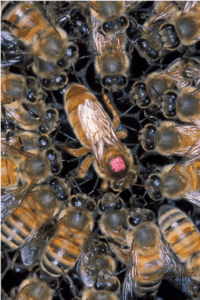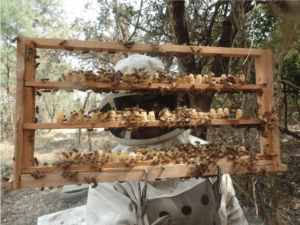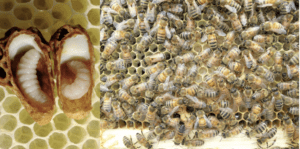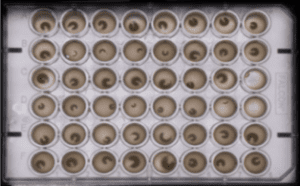Author: Garett Slater, Former Midwest Tech Transfer Team
In part 1 of my blog series, I wrote about how genetics can shape reproductive males (drones) and both reproductive (queens) and non-reproductive (workers) females within a colony. However, genetics only explains part of the story. I will describe why that is in the second installment of my 3-part series:
- Part 1: The Genetic Book of Life-The basics to honey bee genetics (for Part 1 click here)
- Part 2: How Genetics and the Environment Shape Honey Bee Workers and Queens
- Part 3: The Differences Between Queens and Workers

Queen determination has always fascinated researchers and beekeepers. This is unsurprising considering queens and workers are genetically similar yet have distinct anatomical and physiological features (Figure 1). In fact, queens are highly fertile and lay more than 2000 eggs per day whereas workers have anatomical structures specialized for foraging, nursing and other colony tasks. So how does a colony produce either a fertile queen or a sterile, highly specialized worker, even if they have the same genetics?
Most beekeepers and queen producer know nutrition determines whether a fertilized larva develops into a queen or worker. Just place a 1-3-day old larvae into a queenless colony and watch as they develop a queen from a previously worker-destined larvae (Figure 2). However, how this nutrition determines queens has historically perplexed researchers. Since the 1890’s, diet quality has been thought to determine queen-worker castes in honey bees through a “biological active substance” found only in royal jelly. This quality hypothesis arose from early observations of queen and worker larvae receiving different proportions of water-clear and milky-white secretions from nurse bee glands. The milk-white secretion fed to queen-destined larvae was termed royal jelly whereas the water-clear secretion was termed worker jelly (Figure 3). Since then, royal jelly was thought to contain the major dietary components necessary for queen development.


The first person to empirically test differences between royal and worker jelly was Dr. Adolf van Planta in 1888 (Table 1). He concluded the food composition fed to workers changed drastically after the age of 4 days, which is when worker larvae cannot develop into a queen naturally in a colony. While the food fed to workers and queens seem striking, royal jelly content was only quantified for 1 day. However, once this study was published, researchers began to search for the substance in royal jelly that determines caste. In fact, the only other study after Dr. von Planta’s publication to compare differences between royal and worker jelly was Wang et al. 2016.
Royal jelly was then deemed special and necessary for queen development. In fact, royal jelly has been thought to contain a “pure determining substance” not found in worker jelly ever since. This has pushed scientists to find this active substance so we can truly understand how queens develop. Researchers have tested nearly every major component in royal jelly on caste determination. In fact, most studies found positive results. They found lipids, proteins, carbohydrates, water, pantothenic acid (vitamins) and even p-coumaric acid (chemical in pollen) all contribute to queen development in honey bees under some experimental conditions. Despite positive results, how does every single macronutrient and micronutrient in royal jelly determine caste? This question perplexed me.

As I began researching royal jelly and queen development, I realized none of these studies controlled for diet quantity. This is surprising because queens are obviously fed more food than workers during development. In fact, queen-destined larvae are fed an excess of 300mg of diet and are fed 1400 times more frequently by nurse bees than worker-destined larvae. As I did a literature search, I couldn’t believe the impact of quantity on honey bee caste determination has not been formally tested.

I decided to pursue this question during my masters. I used in vitro rearing techniques to test whether diet quantity causes queen development (Figure 4). In vitro rearing is a useful tool because I can become a “nurse” bee and control the food larvae receive. In fact, I can change the type of food and the amount of food larvae receive and see how that impacts development. So, I tested the relative contributions of diet quantity and quality by rearing honey bee larvae on diets that altered both quality and quantity.

A wide range of individuals were raised from my artificial diets. Not only were queens and workers reared, but also intercaste bees (part worker-part queen), or what I call them, princess bees (Figure 5). I have never seen intercaste bees in a natural hive setting nor have I seen miniature workers half the size of normal workers. Thus, it seems bees have the ability to develop into a wide range of body sizes. These results indicate 2 conclusions: 1) nutrition during development is extremely important for both workers and queens, and 2) colonies impressively control queen versus worker development. More importantly, it seems diet quantity plays a larger role in caste determination than expected.
Caste determination is fascinating and I truly enjoyed studying it, but why should the average beekeeper care? The main reason is queens are an integral component of a colony however we have little understanding about how a queen develops and which factors make a high-quality queen. This is important to improve queen quality and manifest important queen traits through breeding, selection, and alternative management practices.
Honey bee queen determination is an intersection between genetics and the environment. I hope you enjoyed reading this post and keep an eye out for the next installment on the key differences between queens and workers.
Citations
von Planta, A. (1888). Ueber den Futtersaft der Bienen. Zeitschrift für physiologische Chemie, 12(4), 327-354.
Wang, Y., Ma, L., Zhang, W., Cui, X., Wang, H., & Xu, B. (2016). Comparison of the nutrient composition of royal jelly and worker jelly of honey bees (Apis mellifera). Apidologie, 47(1), 48-56.